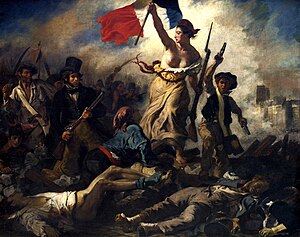Liberty Leading the People
From Wikipedia, the free encyclopedia
 |
| Liberty Leading the People (French: La Liberté guidant le peuple) |
| Eugène Delacroix, 1830 |
| Oil on canvas |
| 260 cm × 325 cm (102.4 in × 128.0 in) |
| Louvre, Paris |
Liberty Leading the People (French: La Liberté guidant le peuple) is a painting by Eugène Delacroix commemorating the July Revolution of 1830, which toppled Charles X. A woman personifying Liberty leads the people forward over the bodies of the fallen, holding the tricolore flag of the French Revolution in one hand and brandishing a bayonetted musket with the other. This is perhaps Delacroix's best-known painting, having carved its own niche in popular culture.
Contents[hide] |
[edit] Painting
Delacroix painted his work in the autumn of 1830. In a letter to his brother dated 12 October, he wrote: "My bad mood is vanishing thanks to hard work. I’ve embarked on a modern subject—a barricade. And if I haven’t fought for my country at least I’ll paint for her." The painting was first exhibited at the official Salon of May 1831. Delacroix rejected the norms of Academicism in favor of Romanticism.
He depicted Liberty, personified by Marianne, symbol of the nation, as both an allegorical goddess-figure and a robust woman of the people, an approach that contemporary critics denounced as "ignoble". The mound of corpses acts as a kind of pedestal from which Liberty strides, barefoot and bare-breasted, out of the canvas and into the space of the viewer. The Phrygian cap she wears had come to symbolise liberty during the French Revolution of 1789.
《自由引導人民》(La Liberté guidant le peuple)是法國浪漫主義畫家德拉克洛瓦記念1830年法國七月革命的作品。
畫中的自由女神戴著象徵自由的弗里吉亞帽,胸部裸露,右手揮舞三色旗,左手持槍,帶領人民起來革命。
The fighters are from a mixture of social classes, ranging from the upper classes represented by the young man in a top hat, to the revolutionary middle class or (bourgeoisie), as exemplified by the boy holding pistols (who may have been the inspiration for the character Gavroche in Victor Hugo's Les Misérables).[1] What they have in common is the fierceness and determination in their eyes. Aside from the flag held by Liberty, a second, minute tricolore can be discerned in the distance flying from the towers of Notre Dame.
The identity of the man in the top hat has been widely debated. The suggestion that it was a self-portrait by Delacroix has been discounted by modern art historians.[2] In the late 19th century, it was suggested the model was the theatre director Etienne Arago; others have suggested the future curator of the Louvre, Frédéric Villot;[1] but there is no firm consensus on this point.
[edit] Usage
The French government bought the painting in 1831 for 3,000 francs with the intention of displaying it in the throne room of the Palais du Luxembourg as a reminder to the "citizen-king" Louis-Philippe of the July Revolution, through which he had come to power. This plan did not come to fruition and the canvas was hung in the Palace museum for a few months before being taken down for its inflammatory political message. Delacroix was permitted to send the painting to his aunt Félicité for safekeeping. It was exhibited briefly in 1848 and then in the Salon of 1855. In 1874, the painting entered the Louvre.
[edit] Legacy
It inspired the Statue of Liberty in New York City, which had been given to the US as a gift from the French only 50 years after "Liberty Leading the People" had been painted. The statue, which holds a torch in its hand, takes a similar stance to the woman in the painting.
An engraved version of this painting, along with a depiction of Delacroix himself, was featured on the 100-franc note in the early 1990s.
The painting is frequently reproduced or reinterpreted in popular culture, and has recently been featured on the front cover of Eric Hobsbawm's Age of Revolution, and in the artwork for Viva La Vida or Death and All His Friends by the British group Coldplay. The painting has had an influence on classical music as well; George Antheil titled his Symphony No. 6 After Delacroix, and stated that the work was inspired by his viewing of a copy of Liberty Leading the People [3]
[edit] References
- ^ a b Pool 1969, p.33.
- ^ Toussaint, Hélene, (1982). La Liberté guidant le peuple de Delacroix. Paris: Editions de la Réunion des Musées Nationaux
- ^ http://www.classical.net/~music/recs/reviews/c/cpo99604a.php
The seminude woman in the middle of the painting represents Liberty and the Republic, who the French calls Marianne. A woman was chosen to present the Republic, because it "symbolizes the breaking the Ancien Régime headed by men". And Republic in French is a feminine noun (la République).
In the painting, the breasts of Marianne are exposed. Firstly, Delacroix tried to "remind us that democracy was born in Ancient Greece by his reference to Nike and his use of partial nudity". Secondly, "during France's first revolution, the one that began in 1789, political cartoonists often symbolized the newly created democratic state as an infant suckled by freedom/Marianne, its mother."
See: http://smarthistory.org/romanticism-in-france.html
and
http://en.wikipedia.org/wiki/Marianne
民衆を導く自由の女神(みんしゅうをみちびくじゆうのめがみ、原題 La Liberté guidant le peuple, 259×325cm, キャンバス、油絵、ルーヴル美術館収蔵)は、ウジェーヌ・ドラクロワによって描かれた絵画。フランス7月革命を主題とする。日本では慣習的に民衆を導く自由の女神と題されることが多いが、原題はLa Liberté guidant le peupleであり、正確には「民衆を導く<自由>」(自由Libertéはアレゴリー)である。このためこの絵画を《民衆を導く<自由>》として紹介する文献も存在する。
絵の中心に描かれている民衆を導く果敢な女性は、フランスのシンボルである、マリアンヌの代表的な例の1つである。原題のLa Liberté guidant le peupleから分かるように、女性は自由を、乳房は母性すなわち祖国を、という具合に、ドラクロワはこの絵を様々な理念を比喩(アレゴリー)で表現している。一方で彼女がかぶるフリギア帽は、フランス革命の間に自由を象徴するようになった。女性の隣に立つ、マスケット銃を手にしたシルクハットの男性はドラクロワ自身であると説明される事が多い。あまりにも政治的で、扇動的であるという理由から、1848年革命まで恒常的な展示は行われなかったという歴史を持つ。
絵画としてのスタイル、フランス7月革命というテーマから、絵画におけるロマン主義の代表作と言える。
1999年に「日本におけるフランス年」の文化財海外交流展の一環として、この絵画がルーブルから東京国立博物館に1ヶ月間貸し出された。この際に日本からフランスに貸し出されたのが法隆寺の百済観音像である。
日本でも「日本におけるフランス年」を記念してこの絵画の記念切手が発行されたが、フランス本国では、ドラクロワの肖像と共に、旧100フラン紙幣にその一部が描かれた。
沒有留言:
張貼留言